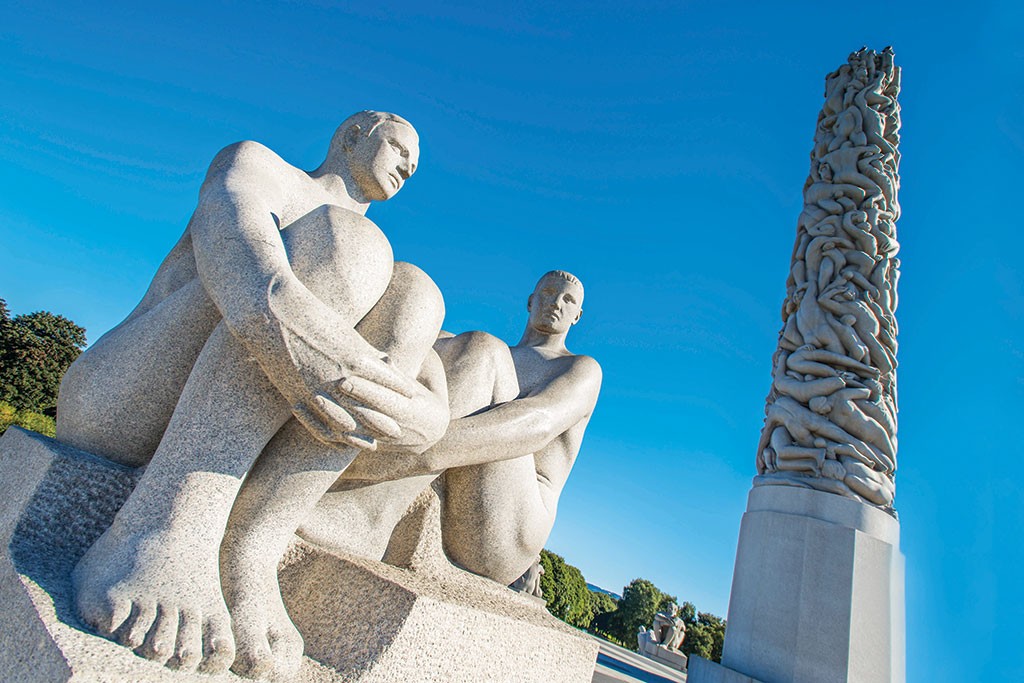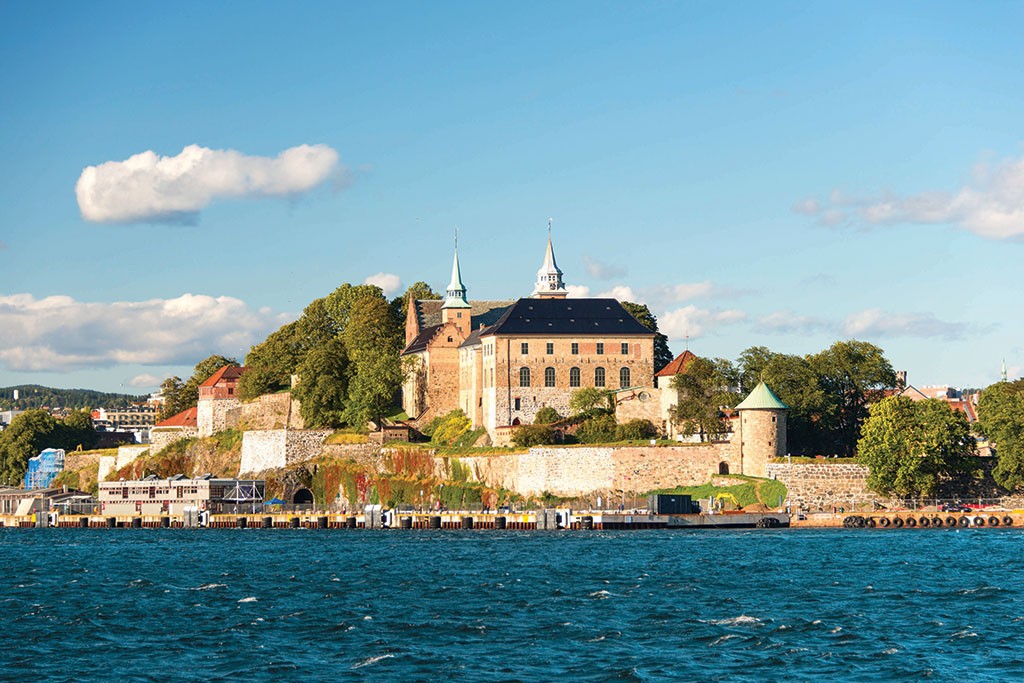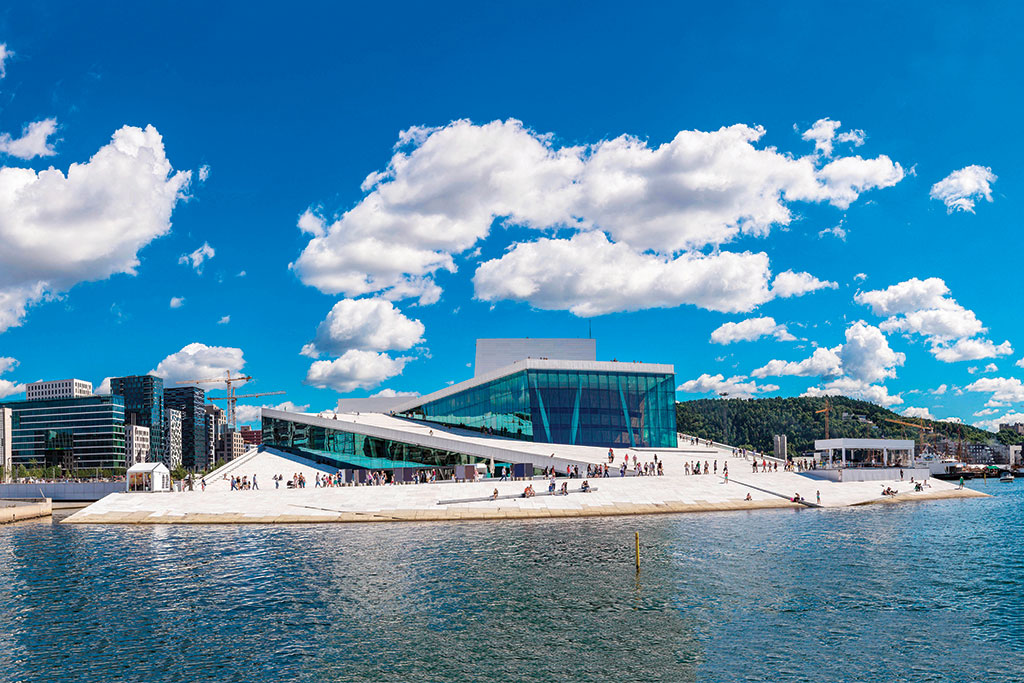From Mocca, I set out walking, and within five minutes come across my hotel almost by accident. I’d had a whole complicated route mapped out, but suddenly I look up and there it is. Oslo is like that. It’s not only pretty impossible to get lost, but even when you’re on the verge of doing so, the city itself steps in and saves you. It’s generous that way, and it makes it easy for a traveler who knows that even if he/she takes a million wrong turns (and who knows where those turns might lead?), chances are good that what you want will suddenly simply appear.
Famished from my explorations, I reserve a table for dinner at St. Raw, in the basement of the Saga. The last thing you’d expect down here is a perfect little sushi restaurant, but that’s what you get. Every dish I have is an explosion of flavor and texture, beginning with the seaweed salad topped with shreds of fried leeks and salmon roe, and continuing with such amazements as ceviche of salmon, halibut, and hamachi with coriander, dill, and avocado, and Norwegian crab sushi. Creatively using a Japanese base and Norwegian ingredients, they create a series of wonders that never cease to explode on the palate.
More pleasures await the next day as I take the tram to the National Theater stop and walk about five minutes to the National Gallery. Of course, the main attraction here is the Edvard Munch room, and the original “The Scream,” but there’s much more on offer, from ancient busts and medieval Russian icons to the work of such masters as Van Dyck, Goya, Picasso, and Matisse. For me, the revelation is the work of the Norwegian painters I hadn’t known, from Thomas Fearnley’s landscapes of rushing rivers and icy crags, to Johan Christian Dahl’s vast panoramas: towering mountain, thundering falls, a rainbow rising above a hilly panorama.
We’re all here to see “The Scream,” though, so I’ll tell you right now it’s in room 18 on the second floor. Interestingly, sitting among a room full of Munch’s works, it’s much smaller than I imagined it. Compared to the icy landscape, portrait of two women in moonlight, and vibrant “dance of life” which surround it, “The Scream” looks positively low-key, hardly what I’d pictured. Its colors are far more muted than in Munch’s other works, which I think render it even more powerful. It’s one of those “OMG I can’t believe I’m seeing this in real life” kind of moments.
From here I walk up the hill to the Akershus Fortress, the medieval castle/fortress that was redone to Renaissance style 300 years later. I explore room after room, century after century: down a claustrophobic brick-arched hallway to the dungeon (well, it’s not supposed to be attractive), up to the beautiful little church, on to the Daredevil (the keep of the old castle), up even more stairs to the astoundingly grand hall of Christian IV, with coffered ceilings, period furniture, and windows open to water views all around. The whole trip takes about a half hour, and as you descend into the modern world below, you’ll be glad you took this leap back through the centuries.

Besides, you’re only steps from the restaurant Festningen in a tiny white building just below the walls of the medieval fortress. The view alone would be worth the trip, with a panorama of the harbor and Oslofjord open- ing up out in the distance. It’s comfortable and elegant, with a design that seamlessly adds modern touches to this old building. Then there’s the food: I have skrei (a type of cod) sitting atop swirls of langoustine and tarragon sauce that’s true perfection. Do I leave room for rum panna cotta with coconut-lime sorbet and grilled pineapple? What do you think?
It’s typical of a new breed of restaurant in Oslo, exemplified by the lovely Fauna, where you’ll take a seat among sand colored walls and a vase of large twigs. Slats at the front of the table section lend privacy and there’s a feeling of laid-back elegance. The tasting menu gives you a chance to sam- ple several of the chef’s creations, and when you’ve made your way through the delights, you’ll see where Fauna’s Michelin star came from. On a little side street that’s less than a ten-minute walk from Karl Johans Gate, it feels like a world apart, a world you’ll want to visit.
Near Fauna is another gem: Havsmak, which has a low-key stylishness, with a huge lacy chandelier at the entrance, a brown and beige palette, and lots of windows. I start with this incredibly complex and wonderful scallop ceviche with cubes of apple jelly and bread made with octopus ink, bright green petit pois crème, dots of bright red chiles, and 3 maroon chips of crispy fried Parma ham. The main course is equally inventive, cod with a spinach and fennel salad, and pureed potatoes with a tube of grilled squid. Dessert? Well, let’s just say the chocolate fondant with Roquefort ice cream and a red wine-soaked pear is my new entry in the best-dessert-ever sweepstakes.
After dinner, it’s time for my gay nightlife tour local friends Kai and Anna Ma, and we head to the so-called “Gay Triangle” where all the bars and clubs are located. We start at So, a very nice place, long and narrow, with brick walls, tile floors, revolving lights, music loud but bearable. It’s clean, cozy, and classy. It’s pretty exclusively lesbian, and they’re trying to keep it that way, so groups of men might be politely direct- ed to one of the other bars nearby. The crowd includes women of all ages, and the feeling is upscale and comfortable.

Next stop: London Pub. Upstairs, it’s all throbbing music, writhing bodies, and raw energy, with one of the most racially diverse crowds in Oslo. Downstairs is more low-key, looking like the London Pub of its name. Low ceilings, flocked wallpaper, and comfy seating areas give it a cozy feel despite its large size, and whether you choose to gather around the pool table, belly up to one of the bars, or stand around in the one of the packed rooms, there’s a friendliness here that makes you feel welcome.
The third place, Elsker, is also very friendly, and mainly young, especially upstairs in the dance lounge, Klubb 9. Up here the music is loud, the lights flashing, the crowd young, hip, and mixed. One woman wears a long beaded gown, while her friend is in jeans and halter top, with heels about two miles high. A guy in tight leather pants dances with a buddy in bright- ly flowered shirt. There’s a small stage where drag shows are performed. Downstairs, the music is mainly Eurovision hits, the crowd is a little older, and there are raised platforms around the edges with seating. There’s also a little side room in case even this level of music is too loud for you. Oslo nightlife is a late-night affair: looking around the packed-like-sardines Elsker at 1 A.M., I ask Randall, a long-time employee, what it would have been like at 10:30 P.M. His answer comes immediately. “You would have been alone,” he says with a smile.
I spend the next day in the area called Grünerløkka, with its hip feel, little shops, and bar and café scene. I know I want to find Tim Wendelboe, reportedly the city’s best coffee place. It’s actually my main priority (hey, we were out late). This is Oslo, so I just start wandering. About two minutes later (what did I tell you?), I see a sign down the street that says “Kaffe.” I’m there.
As I enter, the aroma of fresh beans hits me like a wakeup call. No croissants and open-faced sandwiches, just that amazing coffee, smooth and rich with a bit of a kick. There’s a huge roasting machine upon entry, a counter and two or three chairs, a back room where coffee roasting classes are held, and bags of coffee for sale. These people take their coffee seriously: the bags of beans say things like “aroma of blackberries and sweet cherries” or “berry-like acidity with medium intensity.” It’s an art, and Wendelboe, named both world Barista Cham- pion and World Cup Tasters Champion, is a master.

